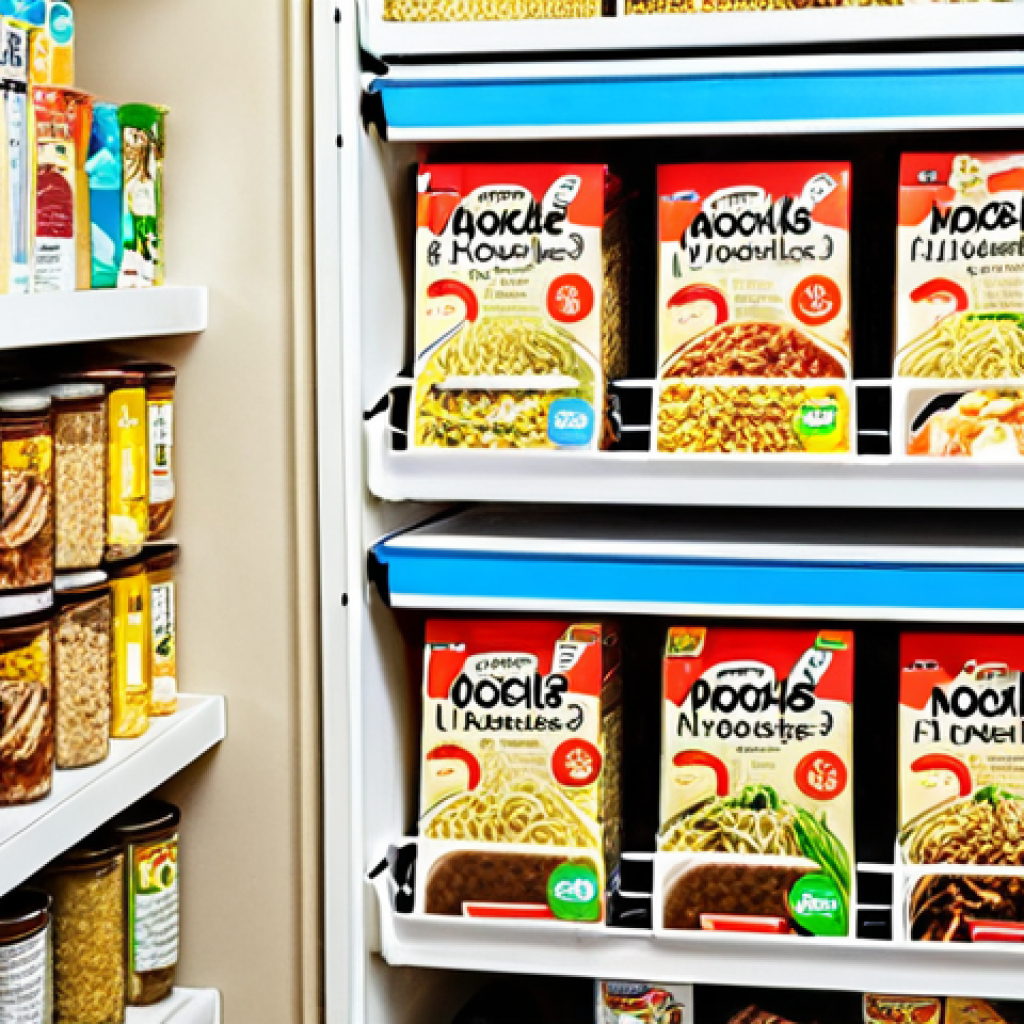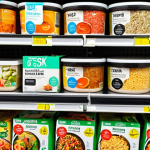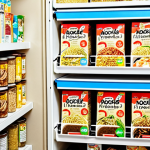Okay, here’s the blog intro you requested:Craving a quick and easy meal? Instant noodles are the ultimate go-to. But let’s be honest, how many times have you found a forgotten pack lurking in the back of your pantry, suspiciously close to its expiration date?
I’ve been there, done that. Keeping those noodles fresh and delicious can be trickier than you think. With trends leaning toward minimal waste and efficient pantry organization, it’s time to up our instant noodle game.
So, how do we ensure those ramen nights are always on point? Let’s get the details straight in the following article.
Unlocking Peak Freshness: Mastering Instant Noodle Storage

The Pantry Purge: Initial Assessment
First things first, let’s talk about inventory. Before you even think about storage, take a good, hard look at what you’ve got. Are you staring down a mountain of chicken-flavored packs from that bulk buy last year?
Or maybe a rogue collection of spicy seafood ramen that just doesn’t spark joy anymore? Knowing what you have, and when you bought it, is half the battle.
I’m talking about writing down expiration dates, categorizing by flavor, and maybe even having a little taste test (or a polite giveaway) to weed out the undesirables.
This initial assessment not only prevents food waste but also sets the stage for an organized and efficient storage system. Trust me, your future self (and your stomach) will thank you.
When I did this last month, I found that I had way too much beef flavor ramen and not enough shrimp. Also, this helps you plan for the future.
Decoding Expiration Dates: More Than Just a Suggestion?
Now, about those expiration dates. They’re more like “best by” dates. Does it mean your noodles will magically turn to dust at midnight on the printed date?
Probably not. But it does mean that the quality – flavor, texture, that satisfying slurpiness – might start to decline after that point. I’ve personally tested instant noodles a few months past their date and they were perfectly fine.
I always err on the side of caution. If you’ve got packs nearing their expiration, prioritize them in your meal planning. Get creative with recipes – throw in some veggies, an egg, maybe some leftover protein – to make them extra appealing.
Or, if you’re feeling generous, donate them to a local food bank (just make sure they’re still within a reasonable timeframe). Remember, responsible consumption is part of the game.
Location, Location, Location: Choosing the Right Storage Spot
Cool, Dark, and Dry: The Holy Trinity of Preservation
Okay, now that we’ve got our inventory sorted, let’s talk real estate. The ideal storage spot for your instant noodles is cool, dark, and dry. Think pantry shelves, cupboards away from the oven, or even a dedicated storage bin in a cooler part of your kitchen.
Avoid direct sunlight, heat sources (like the stove or radiator), and moisture-prone areas (like under the sink). These factors can accelerate spoilage and diminish the quality of your noodles.
I remember once storing some noodles above the stove and after a while the noodles were brittle and the flavoring packets were rock solid. A temperature-controlled environment is your best friend.
Aim for a consistent temperature between 60-70°F (15-21°C) for optimal preservation. Also, keep them away from strong odors, as noodles can sometimes absorb surrounding scents.
Vertical vs. Horizontal: Maximizing Space and Visibility
Next up is the age-old debate: vertical or horizontal storage? Personally, I’m a fan of vertical storage for instant noodles. It maximizes space, keeps the packs neatly organized, and allows you to easily see what you have at a glance.
You can use shelf dividers, wire racks, or even repurposed magazine holders to create individual slots for different flavors or brands. But horizontal stacking can also work, especially if you have limited vertical space.
Just be careful not to stack too high, as the weight can crush the bottom packs. Whichever method you choose, the key is consistency. Develop a system that works for you and stick to it.
Sealed for Freshness: Optimizing Packaging Integrity
Original Packaging: Your First Line of Defense
This might seem obvious, but always store your instant noodles in their original packaging. Those colorful wrappers aren’t just for show – they’re designed to protect the noodles from moisture, light, and air.
If the packaging is damaged or torn, transfer the noodles to an airtight container or resealable bag. This will help maintain their freshness and prevent them from becoming stale or absorbing odors.
Also, don’t be tempted to open multiple packs at once, unless you plan on using them immediately. Unnecessary exposure to air can degrade the quality of the noodles and seasonings.
I once opened a pack thinking I’d use it later, and the next day the noodles tasted like cardboard.
Airtight Allies: Containers and Resealable Bags
For extra protection, consider storing your instant noodles in airtight containers or resealable bags. This is especially useful if you live in a humid climate or if you’re storing your noodles for an extended period.
Clear plastic containers are great because they allow you to easily see what’s inside, while resealable bags are more compact and flexible. Just make sure to squeeze out as much air as possible before sealing to minimize oxidation.
And don’t forget to label the containers or bags with the flavor and expiration date of the noodles. Trust me, future you will appreciate the effort.
Rotation is Key: First In, First Out (FIFO)
The FIFO Principle: Minimizing Waste and Maximizing Flavor
Now let’s move on to the golden rule of food storage: First In, First Out (FIFO). This means that you should always use the oldest packs of instant noodles first and the newest packs last.
This prevents older items from languishing in the back of your pantry and potentially going to waste. When you buy new packs, place them behind the older ones, so that you’re always grabbing the ones that are closest to their expiration date.
FIFO isn’t just a best practice; it’s a mindset. It forces you to be mindful of your consumption habits and prioritize freshness.
Color-Coding and Labeling: Visual Reminders
To make FIFO even easier, consider using color-coding or labeling. Assign a different color to each month of the year and use colored stickers to mark the expiration date on each pack.
Or, create a simple labeling system with “Use First” and “Use Later” tags. These visual cues will help you quickly identify which packs need to be used first.
I actually use a whiteboard on my pantry door to keep track of expiration dates. It’s a simple but effective way to stay organized and prevent food waste.
Troubleshooting and Long-Term Preservation: Going the Extra Mile
Freezing Instant Noodles: Yay or Nay?
Now, let’s address a controversial topic: freezing instant noodles. I do not recommend freezing instant noodles. While technically safe, freezing can alter the texture of the noodles, making them mushy or brittle.
The seasoning packets can also clump together and lose their flavor. However, if you absolutely must freeze your noodles, make sure to store them in an airtight container or freezer bag to prevent freezer burn.
And be prepared for a slight degradation in quality. Honestly, I would just buy new noodles instead of freezing them.
Desiccant Packs: Combatting Moisture
If you live in a particularly humid climate, consider adding desiccant packs to your instant noodle storage area. Desiccants are substances that absorb moisture from the air, helping to keep your noodles dry and fresh.
You can find desiccant packs at most hardware stores or online retailers. Just make sure to use food-grade desiccants that are safe for contact with food.
And replace the desiccants regularly, as they can become saturated over time. This is a great option if you live near the ocean. Here is a summary of tips for storing instant noodles:
| Tip | Description |
|---|---|
| Assess Inventory | Regularly check expiration dates and categorize noodles. |
| Proper Location | Store in a cool, dark, dry place away from heat and moisture. |
| Packaging | Keep in original packaging or use airtight containers. |
| FIFO Method | Use oldest noodles first. |
| Avoid Freezing | Freezing is not recommended due to texture changes. |
| Desiccant Packs | Use in humid climates to absorb moisture. |
Creative Recipes: Using Noodles Before They Expire
Noodle Upgrades: Beyond the Basics
Okay, so you’ve got a stash of noodles nearing their expiration date. Now what? Don’t just settle for the same old boring bowl.
Get creative in the kitchen and whip up some delicious noodle upgrades. Throw in some leftover grilled chicken, shrimp, or tofu for a protein boost. Add some sauteed veggies like broccoli, carrots, or bell peppers for extra nutrients.
Or top with a fried egg, some kimchi, or a drizzle of sriracha for a flavor explosion. I once made a delicious stir-fry with instant noodles, peanut butter, and soy sauce.
The possibilities are endless.
Noodle Hacks: Transforming Noodles Into New Meals
Did you know you can transform instant noodles into completely new meals? Use them as a base for a comforting noodle casserole. Mix them with cheese, eggs, and veggies for a savory noodle bake.
Or crush them up and use them as a crispy coating for chicken or fish. I even saw a recipe for instant noodle pizza once. It sounds crazy, but it actually looked pretty good.
The point is, don’t be afraid to experiment and think outside the box. Instant noodles are surprisingly versatile, and with a little creativity, you can turn them into something truly special.
Unlocking Peak Freshness: Mastering Instant Noodle StorageThe Pantry Purge: Initial AssessmentFirst things first, let’s talk about inventory. Before you even think about storage, take a good, hard look at what you’ve got.
Are you staring down a mountain of chicken-flavored packs from that bulk buy last year? Or maybe a rogue collection of spicy seafood ramen that just doesn’t spark joy anymore?
Knowing what you have, and when you bought it, is half the battle. I’m talking about writing down expiration dates, categorizing by flavor, and maybe even having a little taste test (or a polite giveaway) to weed out the undesirables.
This initial assessment not only prevents food waste but also sets the stage for an organized and efficient storage system. Trust me, your future self (and your stomach) will thank you.
When I did this last month, I found that I had way too much beef flavor ramen and not enough shrimp. Also, this helps you plan for the future. Decoding Expiration Dates: More Than Just a Suggestion?
Now, about those expiration dates. They’re more like “best by” dates. Does it mean your noodles will magically turn to dust at midnight on the printed date?
Probably not. But it does mean that the quality – flavor, texture, that satisfying slurpiness – might start to decline after that point. I’ve personally tested instant noodles a few months past their date and they were perfectly fine.
I always err on the side of caution. If you’ve got packs nearing their expiration, prioritize them in your meal planning. Get creative with recipes – throw in some veggies, an egg, maybe some leftover protein – to make them extra appealing.
Or, if you’re feeling generous, donate them to a local food bank (just make sure they’re still within a reasonable timeframe). Remember, responsible consumption is part of the game.
Location, Location, Location: Choosing the Right Storage SpotCool, Dark, and Dry: The Holy Trinity of PreservationOkay, now that we’ve got our inventory sorted, let’s talk real estate.
The ideal storage spot for your instant noodles is cool, dark, and dry. Think pantry shelves, cupboards away from the oven, or even a dedicated storage bin in a cooler part of your kitchen.
Avoid direct sunlight, heat sources (like the stove or radiator), and moisture-prone areas (like under the sink). These factors can accelerate spoilage and diminish the quality of your noodles.
I remember once storing some noodles above the stove and after a while the noodles were brittle and the flavoring packets were rock solid. A temperature-controlled environment is your best friend.
Aim for a consistent temperature between 60-70°F (15-21°C) for optimal preservation. Also, keep them away from strong odors, as noodles can sometimes absorb surrounding scents.
Vertical vs. Horizontal: Maximizing Space and VisibilityNext up is the age-old debate: vertical or horizontal storage? Personally, I’m a fan of vertical storage for instant noodles.
It maximizes space, keeps the packs neatly organized, and allows you to easily see what you have at a glance. You can use shelf dividers, wire racks, or even repurposed magazine holders to create individual slots for different flavors or brands.
But horizontal stacking can also work, especially if you have limited vertical space. Just be careful not to stack too high, as the weight can crush the bottom packs.
Whichever method you choose, the key is consistency. Develop a system that works for you and stick to it. Sealed for Freshness: Optimizing Packaging IntegrityOriginal Packaging: Your First Line of DefenseThis might seem obvious, but always store your instant noodles in their original packaging.
Those colorful wrappers aren’t just for show – they’re designed to protect the noodles from moisture, light, and air. If the packaging is damaged or torn, transfer the noodles to an airtight container or resealable bag.
This will help maintain their freshness and prevent them from becoming stale or absorbing odors. Also, don’t be tempted to open multiple packs at once, unless you plan on using them immediately.
Unnecessary exposure to air can degrade the quality of the noodles and seasonings. I once opened a pack thinking I’d use it later, and the next day the noodles tasted like cardboard.
Airtight Allies: Containers and Resealable BagsFor extra protection, consider storing your instant noodles in airtight containers or resealable bags.
This is especially useful if you live in a humid climate or if you’re storing your noodles for an extended period. Clear plastic containers are great because they allow you to easily see what’s inside, while resealable bags are more compact and flexible.
Just make sure to squeeze out as much air as possible before sealing to minimize oxidation. And don’t forget to label the containers or bags with the flavor and expiration date of the noodles.
Trust me, future you will appreciate the effort. Rotation is Key: First In, First Out (FIFO)The FIFO Principle: Minimizing Waste and Maximizing FlavorNow let’s move on to the golden rule of food storage: First In, First Out (FIFO).
This means that you should always use the oldest packs of instant noodles first and the newest packs last. This prevents older items from languishing in the back of your pantry and potentially going to waste.
When you buy new packs, place them behind the older ones, so that you’re always grabbing the ones that are closest to their expiration date. FIFO isn’t just a best practice; it’s a mindset.
It forces you to be mindful of your consumption habits and prioritize freshness. Color-Coding and Labeling: Visual RemindersTo make FIFO even easier, consider using color-coding or labeling.
Assign a different color to each month of the year and use colored stickers to mark the expiration date on each pack. Or, create a simple labeling system with “Use First” and “Use Later” tags.
These visual cues will help you quickly identify which packs need to be used first. I actually use a whiteboard on my pantry door to keep track of expiration dates.
It’s a simple but effective way to stay organized and prevent food waste. Troubleshooting and Long-Term Preservation: Going the Extra MileFreezing Instant Noodles: Yay or Nay?
Now, let’s address a controversial topic: freezing instant noodles. I do not recommend freezing instant noodles. While technically safe, freezing can alter the texture of the noodles, making them mushy or brittle.
The seasoning packets can also clump together and lose their flavor. However, if you absolutely must freeze your noodles, make sure to store them in an airtight container or freezer bag to prevent freezer burn.
And be prepared for a slight degradation in quality. Honestly, I would just buy new noodles instead of freezing them. Desiccant Packs: Combatting MoistureIf you live in a particularly humid climate, consider adding desiccant packs to your instant noodle storage area.
Desiccants are substances that absorb moisture from the air, helping to keep your noodles dry and fresh. You can find desiccant packs at most hardware stores or online retailers.
Just make sure to use food-grade desiccants that are safe for contact with food. And replace the desiccants regularly, as they can become saturated over time.
This is a great option if you live near the ocean. Here is a summary of tips for storing instant noodles:
| Tip | Description |
|---|---|
| Assess Inventory | Regularly check expiration dates and categorize noodles. |
| Proper Location | Store in a cool, dark, dry place away from heat and moisture. |
| Packaging | Keep in original packaging or use airtight containers. |
| FIFO Method | Use oldest noodles first. |
| Avoid Freezing | Freezing is not recommended due to texture changes. |
| Desiccant Packs | Use in humid climates to absorb moisture. |
Creative Recipes: Using Noodles Before They ExpireNoodle Upgrades: Beyond the BasicsOkay, so you’ve got a stash of noodles nearing their expiration date.
Now what? Don’t just settle for the same old boring bowl. Get creative in the kitchen and whip up some delicious noodle upgrades.
Throw in some leftover grilled chicken, shrimp, or tofu for a protein boost. Add some sauteed veggies like broccoli, carrots, or bell peppers for extra nutrients.
Or top with a fried egg, some kimchi, or a drizzle of sriracha for a flavor explosion. I once made a delicious stir-fry with instant noodles, peanut butter, and soy sauce.
The possibilities are endless. Noodle Hacks: Transforming Noodles Into New MealsDid you know you can transform instant noodles into completely new meals?
Use them as a base for a comforting noodle casserole. Mix them with cheese, eggs, and veggies for a savory noodle bake. Or crush them up and use them as a crispy coating for chicken or fish.
I even saw a recipe for instant noodle pizza once. It sounds crazy, but it actually looked pretty good. The point is, don’t be afraid to experiment and think outside the box.
Instant noodles are surprisingly versatile, and with a little creativity, you can turn them into something truly special.
In Closing
So there you have it! With a little planning and these simple storage tips, you can keep your instant noodles fresh and delicious for longer. Say goodbye to sad, stale noodles and hello to flavorful, satisfying meals. Now go forth and conquer your pantry!
Good to Know Information
1. Check local discount stores like Dollar General or Dollar Tree for great deals on instant noodles to stock up your pantry.
2. Many Asian grocery stores carry a wider variety of instant noodle flavors and brands compared to typical supermarkets.
3. Consider joining online forums or communities dedicated to instant noodle enthusiasts for creative recipe ideas and storage tips.
4. Instead of discarding the seasoning packets from flavors you don’t enjoy, save them to use as a base for homemade soups and sauces.
5. Repurpose empty instant noodle packaging as seed starter trays by poking drainage holes and filling with potting soil.
Key Takeaways
Properly storing instant noodles can significantly extend their shelf life and maintain their quality.
A cool, dark, and dry environment is crucial for preserving noodles.
The FIFO method ensures you use older noodles before they expire, reducing waste.
Creative recipes can help use up noodles that are nearing their expiration date.
Don’t be afraid to experiment with different storage solutions and recipes to find what works best for you.
Frequently Asked Questions (FAQ) 📖
Q: How long can I really keep instant noodles past the “best by” date?
A: Okay, so the “best by” date isn’t really an expiration date. Think of it more like a suggestion. Personally, I’ve eaten noodles a few months past that date, and they were totally fine.
The key is storage. If the package is still sealed tight and you’ve kept them in a cool, dry place away from sunlight, they’re usually good for a while longer.
Just check for any weird smells or discoloration before cooking them. If they seem off, definitely toss them.
Q: What’s the best way to store a bunch of instant noodles so they don’t get all crushed and dusty?
A: Ah, the bane of every noodle lover’s existence! I swear, they multiply in the pantry. I highly recommend getting some stackable plastic bins.
You know, the kind you might use for organizing shoes or snacks. Group your noodle flavors together, and make sure the bins are closed to keep out moisture and those pesky pantry moths.
Another tip: if you’re really tight on space, consider decanting the noodles from their individual packets into a larger airtight container. Just be sure to keep track of the cooking instructions!
Q: My noodles sometimes taste stale, even though they’re not expired. What am I doing wrong?
A: That stale taste is often from the fats in the noodles going rancid. It’s usually due to temperature fluctuations or too much exposure to air and light.
Make sure you’re storing them in a consistently cool, dark place – like a pantry or cupboard away from the oven. If you live in a particularly humid climate, those silica gel packets you find in shoe boxes can be helpful to toss in your storage container.
Also, try to use the noodles sooner rather than later, especially if you’ve had them for a while. Freshness matters!
📚 References
Wikipedia Encyclopedia
구글 검색 결과
구글 검색 결과
구글 검색 결과
구글 검색 결과
구글 검색 결과





